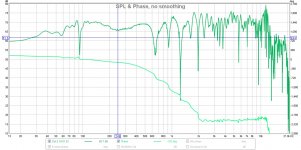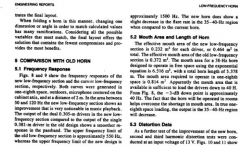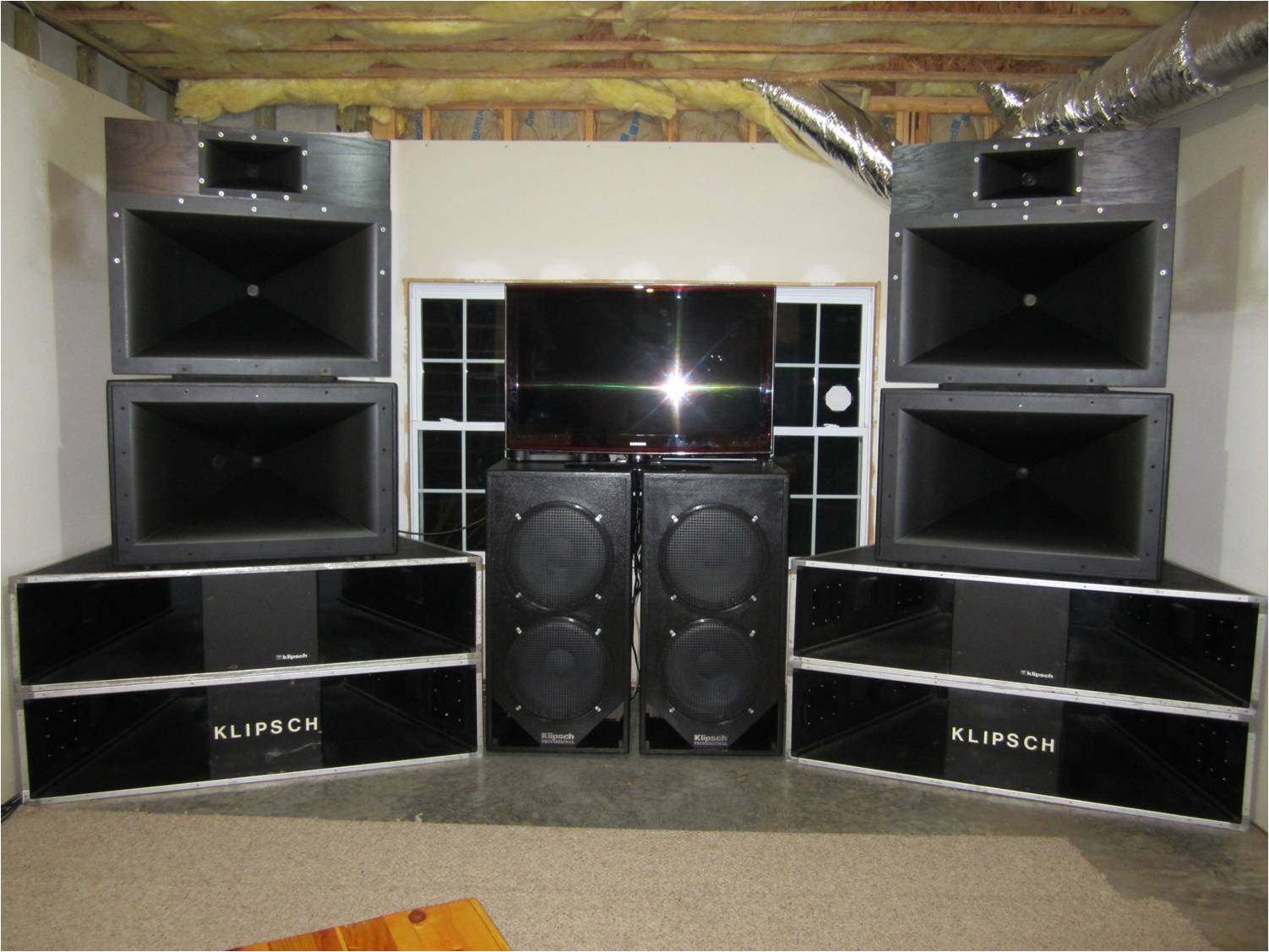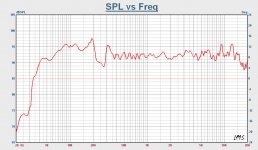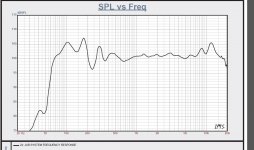The ripples you mention are frequency dependent - if you cross at a lower frequency, the two mouths will not diffract. The K-402 with compression driver easily loads down to 450 Hz--in fact, the same horn itself is used in a K-305 midbass horn loads to 150 Hz, which would be a solution to the OP's questions if he has even considered it. It was mentioned in another forum but no word from the OP on why that design isn't coming into solution.
What kind of straight midbass horn is compact, assuming you're designing to the specifications listed above by the OP (80-600 Hz, 60 x 90 degrees coverage, freestanding--no boundary effects)? The linked bass bin is the only one that I've seen that does that--when used in freestanding applications.
The front panel of the Jubilee is 21.25" wide. In order for the two mouths to mutually couple you have to get within 1/3 a wavelength before the rippling starts to go away. That limits the upper frequency to around 215Hz. That clearly does not meet the OP's requirements. The OP needs to realize physics can’t be cheated. There is no such thing as a compact mid bass horn that can cover 80Hz to 600Hz. The specs for K-305 mid bass horn look suspect to me. How exactly do you get response down to 150Hz in a horn that is shorter than 18 inches?
Last edited:
Thank you Leif for your invitation. Your setup has been an inspiration to me. Would be nice to visit if I'm in the area one day.you know where you can hear these with dual JBL 2220B
I don't understand why the K-305 could be a solution to me when its response is -3dB at 150 Hz. I need something that goes lower.The ripples you mention are frequency dependent - if you cross at a lower frequency, the two mouths will not diffract. The K-402 with compression driver easily loads down to 450 Hz--in fact, the same horn itself is used in a K-305 midbass horn loads to 150 Hz, which would be a solution to the OP's questions if he has even considered it. It was mentioned in another forum but no word from the OP on why that design isn't coming into solution.
I'll take a closer look at the free standing bass bin. However, the measurements I've seen of folded horns up to this point are not comparable to a front loaded horn. But correct me If I'm mistaken anyone.What kind of straight midbass horn is compact, assuming you're designing to the specifications listed above by the OP (80-600 Hz, 60 x 90 degrees coverage, freestanding--no boundary effects)? The linked bass bin is the only one that I've seen that does that--when used in freestanding applications.
The hyperbolic seems to be more even then a straight conical horn and perhaps the better option. The drawback is a tougher design that requires CNC.
I see. A totally different approach.I have not seen a polar map of the Klipsch KPT-XII-MB mid bass horn.
I was suggesting using your K-402 as a Synergy horn. To extend the response down only an octave could use small drivers with small port holes, to go down to 80-100 Hz would require larger drivers and larger holes and bass reflex porting.
As you can see in this thread, using some 10" on a smaller horn than yours gets response below 100 Hz, though requires EQ. Your wider vertical dispersion will not load as low as my more narrow vertical dispersion conical horn.
http://www.diyaudio.com/forums/multi-way/262838-synergy-tripp-10-a.html
Since you really only need another octave or so more mid response to work well with your 15"s, it would be quite simple to add four sealed back midrange to the K-402 horn. Hole saw, a little bit of filing and sanding, screw on the drivers, could be done in an afternoon of work, though the driver decision seems to take most of the Synergy builders an inordinate amount of time 😉.
Art
I don't know. Haven't looked into synergy horn much and didn't thought was as easy as taking "whatever" horn and add holes and drivers besides an advanced crossover setting. Doesn't an optimal synergy horn requires a certain profile?
The K-402 has cost me quite a bit and I wouldn't take a chance on drilling holes before I was 100% sure on the design. Would be sad to waste the K-402 on a failed product. Perhaps better to start with another horn profile from the beginning if I wanted to try synergy horn?
Synergy horn with a coxial approach for a nice and smooth crossover certaintly is something that's tempting though. Thanks for the link to the thread. Subscribed.
1) Synergy horns use a conical expansion with the secondary portion double the initial angle. Your K-402 looks like that, with a smoother transition between the two horn parts than the typical wood Synergy horns, and the entry also looks a little smoother, but DSL's molded SM Synergy horns take advantage of the process and have a more rounded profile that looks a bit more like the K-402.1) Doesn't an optimal synergy horn requires a certain profile?
2)The K-402 has cost me quite a bit and I wouldn't take a chance on drilling holes before I was 100% sure on the design. Would be sad to waste the K-402 on a failed product. Perhaps better to start with another horn profile from the beginning if I wanted to try synergy horn?
2) If you were using small mid drivers, the holes could easily be patched with application of a fiberglass backing and smoothed with Bondo if you for some reason did not "get it right" the first time. With modeling, it is not too difficult to "get it right", though is still is best to start with the holes a bit small, measure, and increase to achieve the modeled response, rather than have to fill in holes that turn out to be too large.
You could do a foam board mock up of your horn and test actual speakers on it at low volume to test before doing anything with your horns.
Wow, just like that, it won't work...except that the OP said nothing about ripple - you did.The front panel of the Jubilee is 21.25" wide. In order for the two mouths to mutually couple you have to get within 1/3 a wavelength before the rippling starts to go away. That limits the upper frequency to around 215Hz. That clearly does not meet the OP's requirements.
Attachments
All the measurements that are posted on the Jub bass bin from Klipsch are anechoic, i.e., not in a corner or against a wall - or even a floor: full space.I don't understand why the K-305 could be a solution to me when its response is -3dB at 150 Hz. I need something that goes lower.
I'll take a closer look at the free standing bass bin. However, the measurements I've seen of folded horns up to this point are not comparable to a front loaded horn. But correct me If I'm mistaken anyone.
The Jub bass bin is a front-loaded horn - but folded, meaning it will have a low pass characteristic--unlike straight horns which do not.
Chris
Chris,All the measurements that are posted on the Jub bass bin from Klipsch are anechoic, i.e., not in a corner or against a wall - or even a floor: full space.
The Jubilee was measured outdoors, in 1/8 space condition, in other words, they built a corner for it.
In 5.2 it mentions the mouth area needed to operate in free space would be 6.516 meters square, "the fact that the horn will be operating in rooms helps overcome the shortage in mouth area".
Art
Attachments
I guess the measured plot above isn't enough? It does a lot better in a corner, like all bass bins (if you would like to read that article, I've got it), but it can be used without a corner--or a wall--or even a floor. It's up the the user. The plot is called khjub.pdf for the anechoic version, not EQed as above.Chris,
The Jubilee was measured outdoors, in 1/8 space condition, in other words, they built a corner for it.
In 5.2 it mentions the mouth area needed to operate in free space would be 6.516 meters square, "the fact that the horn will be operating in rooms helps overcome the shortage in mouth area".
Art
Omholt - I've got the Dx38 settings that produced the unsmoothed plot above for a Jub bass bin and K-402 with TAD TD-4002 drivers.
Chris
Last edited:
I guess that you 're from Missouri? It's been my experience that the specifications published by Roy Delgado at Klipsch (Pro Products) are always accurate. I do not own a KPT-305, but I suppose that I have to have a plot of test data to refute any statements of non-belief, too? The two horns in the middle of this cinema stack are the 402 and 305, respectively.The OP needs to realize physics can’t be cheated. There is no such thing as a compact mid bass horn that can cover 80Hz to 600Hz. The specs for K-305 mid bass horn look suspect to me. How exactly do you get response down to 150Hz in a horn that is shorter than 18 inches?
Chris

Last edited:
I'm not planning to corner load. So I need enough output to at least 110 Hz from the midbass horn. Below, my JBL 2226 towers will take over.All the measurements that are posted on the Jub bass bin from Klipsch are anechoic, i.e., not in a corner or against a wall - or even a floor: full space.
The Jub bass bin is a front-loaded horn - but folded, meaning it will have a low pass characteristic--unlike straight horns which do not.
Chris
I'm not in the position to know what's the better midbass horn but Parham together with others have convinced me that a folded horn isn't optimal above 100-200 Hz. However, I'm very open to a discussion on it from those who have experience and knowledge. I need to be a fly on the wall. 😉
AudioRoundTable.com: Pi Speakers => ? Constant Directivity Cornerhorn: Bass Bin Design Details
When was the last time that Wayne built a folded bass horn (i.e., not a sub) that covers a decade of passband extremely well? I think that he found what lot of others have - it takes a lot of time and resources to do it well. Otherwise, Wayne does seem to be very good in terms of his kits.
I own a pair, and for your requirements/constraints, I can think of no better solution (save the money part if you were to build a pair of midbass horns yourself). Compared to the straight conical horns shown above by your local acquaintance, Jub bass bins are very compact. My bins sound very good above 600 Hz crossing. I simply prefer the sound of the 402s/TADs down to 430 Hz, where I currently cross them, and the directivity of the bass bin and the 402s match at that lower frequency--which is a pretty big deal. A little time spent EQing them into your exact living space makes a big difference, just like any horn-loaded loudspeaker system.
If you locate the bass bins to within a half metre of a wall, their FR will get even better. Located in corners, they're good to 31 Hz, EQed.
I know your room constraints, though.
I own a pair, and for your requirements/constraints, I can think of no better solution (save the money part if you were to build a pair of midbass horns yourself). Compared to the straight conical horns shown above by your local acquaintance, Jub bass bins are very compact. My bins sound very good above 600 Hz crossing. I simply prefer the sound of the 402s/TADs down to 430 Hz, where I currently cross them, and the directivity of the bass bin and the 402s match at that lower frequency--which is a pretty big deal. A little time spent EQing them into your exact living space makes a big difference, just like any horn-loaded loudspeaker system.
If you locate the bass bins to within a half metre of a wall, their FR will get even better. Located in corners, they're good to 31 Hz, EQed.
I know your room constraints, though.
Last edited:
Having never heard one, I agree on a folded horn being sub optimal trying for 600hz, but..................
With a smooth enough expansion it is possible.
Think of the huge western electric 15a horn.
DIY Western Electric 15A horns ll - YouTube
A front horn would be an easier build, deeper, but easier.
With a smooth enough expansion it is possible.
Think of the huge western electric 15a horn.
DIY Western Electric 15A horns ll - YouTube
A front horn would be an easier build, deeper, but easier.
RCA-Fan's 70Hz horn for 1-12" - - dunno about the DI of its 13.5" x 22" mouth
http://usr.audioasylum.com/images/2/21168/2Bwith_reflector.gif
http://usr.audioasylum.com/images/2/21168/2Bwith_reflector.gif
Last edited:
I'm afraid I will chicken out on your suggestion. A bit too radical approach for me. I'd rather get a synergy horn built from scratch later if I'm convinced after hearing it.1) Synergy horns use a conical expansion with the secondary portion double the initial angle. Your K-402 looks like that, with a smoother transition between the two horn parts than the typical wood Synergy horns, and the entry also looks a little smoother, but DSL's molded SM Synergy horns take advantage of the process and have a more rounded profile that looks a bit more like the K-402.
2) If you were using small mid drivers, the holes could easily be patched with application of a fiberglass backing and smoothed with Bondo if you for some reason did not "get it right" the first time. With modeling, it is not too difficult to "get it right", though is still is best to start with the holes a bit small, measure, and increase to achieve the modeled response, rather than have to fill in holes that turn out to be too large.
You could do a foam board mock up of your horn and test actual speakers on it at low volume to test before doing anything with your horns.
What's your take on a jubilee bass bin (with no corner mounting) vs conical/hyperbolic?
Is this a measurement of K-305 or the Jube bass bin? You've been talking about both. How and where was it measured?Wow, just like that, it won't work...except that the OP said nothing about ripple - you did.
Nothing would be better if the Jub bass bin measures really well. Like you say, it's compact. And I would have the option of corner loading later it that becomes a possibility.When was the last time that Wayne built a folded bass horn (i.e., not a sub) that covers a decade of passband extremely well? I think that he found what lot of others have - it takes a lot of time and resources to do it well. Otherwise, Wayne does seem to be very good in terms of his kits.
I own a pair, and for your requirements/constraints, I can think of no better solution (save the money part if you were to build a pair of midbass horns yourself). Compared to the straight conical horns shown above by your local acquaintance, Jub bass bins are very compact. My bins sound very good above 600 Hz crossing. I simply prefer the sound of the 402s/TADs down to 430 Hz, where I currently cross them, and the directivity of the bass bin and the 402s match at that lower frequency--which is a pretty big deal. A little time spent EQing them into your exact living space makes a big difference, just like any horn-loaded loudspeaker system.
If you locate the bass bins to within a half metre of a wall, their FR will get even better. Located in corners, they're good to 31 Hz, EQed.
I know your room constraints, though.
However, looking at the two measurements I've seen of Jubilee, I don't see an even response or something that should indicate a similar directivity at the crossover.
This certaintly doesn't look well. This is anechoic also (at least one is) if I'm not mistaken. How can this compare to a conical/hyperbolic horn?
Attachments
And here's a measurement of the final Jube bass bin prototype from the AES paper earlier posted in this thread. Not exactly stellar.
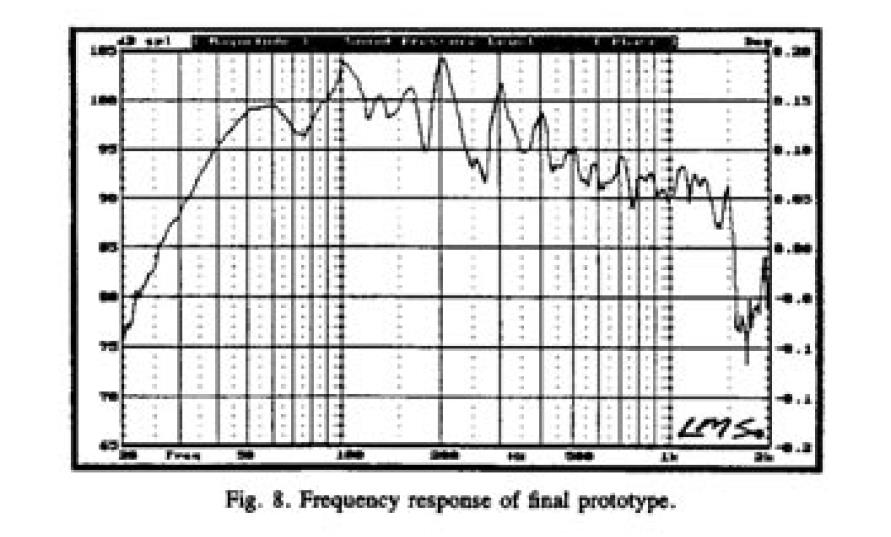
For me it seem the folded horn hasn't been chosen because it's the best midbass horn or matches the K-402 in the best way, but because it's compact, can be corner loaded and gives output lower in frequency. The latter being absolutely vital when you have a commercial product. No one would build and sell a speaker system in those days where you're required to use a subwoofer from 80-100 Hz.
For me it seem the folded horn hasn't been chosen because it's the best midbass horn or matches the K-402 in the best way, but because it's compact, can be corner loaded and gives output lower in frequency. The latter being absolutely vital when you have a commercial product. No one would build and sell a speaker system in those days where you're required to use a subwoofer from 80-100 Hz.
Attachments
- Home
- Loudspeakers
- Multi-Way
- Pros and cons of different midbass horns
